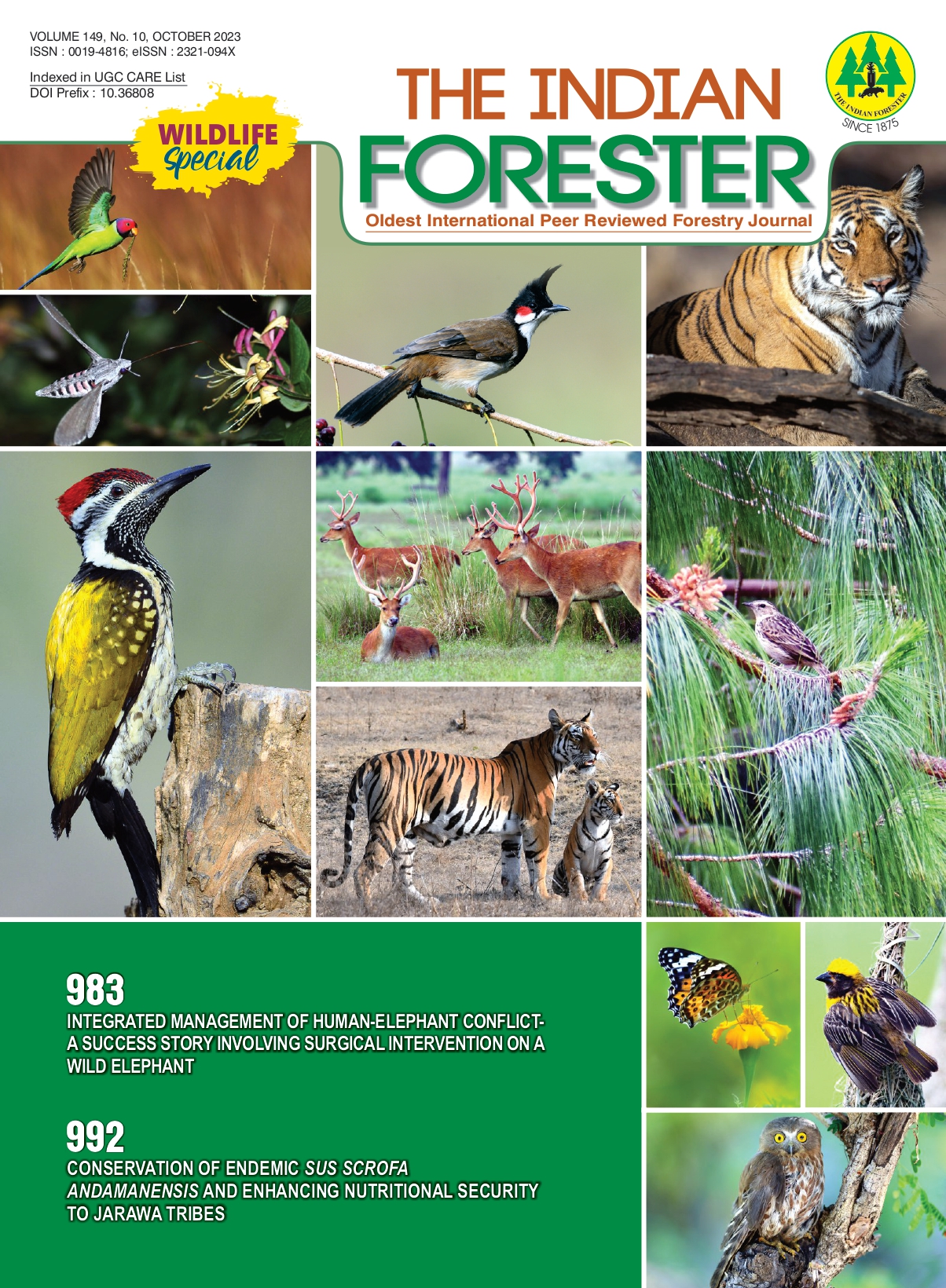Understanding Elephant Movement Paths in a Fragmented Corridor Using Animal Energetics
DOI:
https://doi.org/10.36808/if/2023/v149i10/169834Keywords:
Conflict, Corridor Connectivity, Efficacy, Manas Trans-Boundary Conservation Area, Movement Ecology.Abstract
In this paper, the authors present an energetics analysis of the movement paths of elephants in the Manas Transboundary Conservation area. With degrading habitat and corridor connectivity rapidly being lost due to deforestation and encroachment, elephants are being pushed to explore alternative migration routes, often leading them to human-dominated landscapes resulting in an increasing conflict situation. Authors explored the possibility of the forests of Bhutan being utilised as one alternative route by the elephant herds using computation of energy requirements vis-a-vis the extant corridor routes. We found that the alternative pathways are as much as five times more energy intensive than the existing routes, with per kilometer energy requirements being around 2.5 times the current per kilometer requirements. These calculations demonstrate that the alternative routes explored are unsuitable for the migration of elephants and that restoration of corridor connectivity is urgently required to avoid situations of conflict or population decimation of elephants.References
Allan J.R., Venter O., Maxwell S., Bertzky B., Jones K., Shi Y. and Watson J.E. (2017). Recent increases in human pressure and forest loss threaten many Natural World Heritage Sites. Biological conservation, 206: 47-55.
Allen D.J., Molur S. and Daniel B.A. (2010). The Status and Distribution of Freshwater Biodiversity in the Eastern Himalaya. IUCN, International Union for Conservation of Nature and Natural Resources.
Ben-Shahar R. (1993). Patterns of elephant damage to vegetation in northern Botswana. Biological conservation, 65: 249-256.
Choudhury A. (1999). Status and conservation of the Asian Elephant Elephas maximus in north eastern India. Mammal Review, 29: 141-174.
Douglas-Hamilton I., Krink T. and Vollrath F. (2005). Movements and corridors of African elephants in relation to protected areas. Naturwissenschaften, 92: 158-163.
Eaton J., Bateman D., Hauberg S. and Wehbring R. (2015). GNU Octave version 4.0. 0 manual: a high-level interactive language for numerical computations In: CreateSpace Independent Publishing Platform. March.
Halsey L.G. and White C.R. (2017). A different angle: comparative analyses of whole-animal transport costs when running uphill. Journal of Experimental Biology, 220: 161-166.
Jigme K. and Williams A.C. (2011). Current status of Asian elephants in Bhutan. Gajah, 35: 25-28.
Joshi R. and Singh R. (2008). Asian elephant (Elephas maximus) and riparian wildlife corridors: A case study from lesser-Himalayan zone of Uttarakhand. The Journal of American Science, 4: 63-75.
Kahumbu P. (2002). The effects of elephants on their habitats in the Shimba Hills, Kenya.
Langman V., Roberts T., Black J., Maloiy G., Heglund N., Weber J., Kram R. and Taylor C. (1995). Moving cheaply: energetics of walking in the African elephant. Journal of Experimental Biology, 198: 629-632.
Laws R.M. (1970). Elephants as agents of habitat and landscape change in East Africa. Oikos, 1-15.
Lin L., Zhu W., Zhang L., Feng L., Wang L., Tao Q. and Zhang L. (2008). 325 The opening up and utilization of a new movement corridor by Asian elephants (Elephas maximus) in Shangyong Nature Reserve, Yunnan.
Mittermeier R.A., Myers N., Thomsen J.B., Da Fonseca G.A. and Olivieri S. (1998). Biodiversity hotspots and major tropical wilderness areas: approaches to setting conservation priorities. Conservation biology, 12: 516-520.
Mwalyosi R. (1991). Ecological evaluation for wildlife corridors and buffer zones for Lake Manyara National Park, Tanzania, and its immediate environment. Biological Conservation, 57: 171-186.
Nath N.K., Lahkar B.P., Brahma N., Dey S., Das J.P., Sarma P.K. and Talukdar B.K. (2009). An assessment of human-elephant conflict in Manas National Park, Assam, India. Journal of Threatened Taxa, 1: 309-316.
Pandit M., Sodhi N.S., Koh L.P., Bhaskar A. and Brook B.W. (2007). Unreported yet massive deforestation driving loss of endemic biodiversity in Indian Himalaya. Biodiversity and Conservation, 16: 153-163.
Price T.D., Hooper D.M., Buchanan C.D., Johansson U.S., Tietze D.T., Alström P., Olsson U., Ghosh-Harihar M., Ishtiaq F. and Gupta S.K. (2014). Niche filling slows the diversification of Himalayan songbirds. Nature, 509: 222.
Santiapillai C. and Jackson P. (1990). The Asian elephant: an action plan for its conservation. IUCN.
Sukumar R. (2003). The living elephants. Evolutionary ecology, behavior, and conservation.
Van Wyk P. and Fairall N. (1969). The influence of the African elephant on the vegetation of the Kruger National Park. Koedoe, 12: 57-89.
Wall J., Douglas-Hamilton I. and Vollrath F. (2006). Elephants avoid costly mountaineering. Current Biology, 16: R527-R529.
Wilson S., Davies T.E., Hazarika N. and Zimmermann A. (2015). Understanding spatial and temporal patterns of human–elephant conflict in Assam, India. Oryx, 49: 140-149.
Downloads
Downloads
Published
How to Cite
Issue
Section
License
Unless otherwise stated, copyright or similar rights in all materials presented on the site, including graphical images, are owned by Indian Forester.





